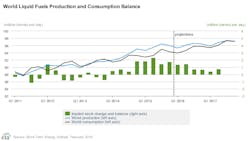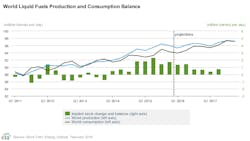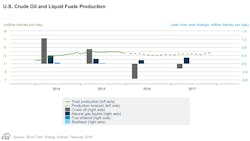EIA forecasts lower oil prices, higher inventories in 2016
In its February Short-Term Energy Outlook (STEO), the US Energy Information Administration forecast Brent crude prices to average $37.52/bbl in 2016, compared with a previous forecast of $40.15/bbl. West Texas Intermediate prices are expected to average $37.59/bbl, down from $38.54/bbl forecasted last month. For 2017, EIA raised its outlook for WTI to $50/bbl from $47/bbl, while leaving the Brent forecast at $50/bbl.
In the report, EIA forecast global oil inventories to increase by annual average of 1 million b/d in 2016 and by an additional 300,000 b/d in 2017, both higher than previous forecasts.
EIA estimates global consumption of petroleum and other liquid fuels increased 1.4 million b/d in 2015, averaging 93.8 million b/d for the year. EIA expects global consumption to rise 1.2 million b/d in 2016 and 1.5 million b/d in 2017, compared with forecasts of 1.4 million b/d for both years in last month’s STEO.
Non-OPEC production
EIA expects production outside of the Organization of Petroleum Exporting Countries to decline 600,000 b/d in 2016, which would be the first decline since 2008. Most of the forecast production decline in 2016 is expected to be in the US, due to high decline rates and relatively short investment horizons. Non-OPEC production is forecast to decline 200,000 b/d in 2017.
“Forecast total US liquid fuels production declines by 500,000 b/d in 2016, as low oil prices contribute to drilling rig counts falling below levels required to sustain current production. In 2017, US liquid fuels production is relatively flat,” EIA said.
“The expectation of reduced cash flows in 2016 and 2017 has prompted many companies to scale back investment programs, deferring major new undertakings until a sustained price recovery occurs. The prospect of higher interest rates and tighter lending conditions will likely limit the availability of capital for many smaller producers, giving rise to distressed asset sales and consolidation of acreage holdings by more financially sound firms.”
EIA forecasts that US crude oil production will decrease from an average of 9.4 million b/d in 2015 to 8.7 million b/d in 2016 and to 8.5 million b/d in 2017.
Outside the US, forecast non-OPEC production declines by 100,000 b/d in 2016 and by 300,000 b/d in 2017. Despite low crude oil prices, production declines are relatively minor because of investments committed to projects when oil prices were higher. Additionally, recent strength in the US dollar and cost reductions have moderated the effects of declining oil revenues on production in some countries.
Among other non-OPEC producers, the largest declines are forecast to be in the North Sea and Russia, EIA said.
OPEC production
Forecast OPEC crude oil production increases 700,000 b/d in 2016 and 600,000 b/d in 2017, with Iran accounting for most of the increase. EIA assumes that a collaborative production cut among OPEC members and other major producers does not occur in the forecast period, as major OPEC producers continue the strategy to maintain market share.
“Iran’s crude oil production, which averaged 2.8 million b/d in 2015, is forecast to average more than 3.1 million b/d in 2016 and almost 3.6 million b/d in 2017, with the actual outcome dependent on Iran’s ability to mitigate production decline rates, deal with technical challenges, and bring new oil fields online,” EIA said.


